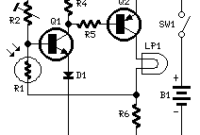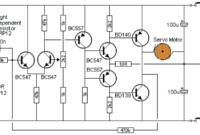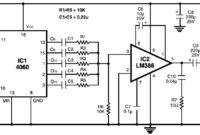
This is a simple and easy built electronic candle circuit which build using TTL (transistor-transistor logic) that are 74LS164, 74LS86 and 74LS00. This circuit will give the effect of candle light in a normal 220V electric bulb lamp. A candle light, as we all know, resembles a randomly?glimmering light. So, the objective of this project activity is to produce a randomly?glimmering light effect in an electric bulb lamp.
The entire circuit can be divided into three parts:
- The first part consists of? IC1 (555), IC2 (74LS164), IC3 (74LS86), IC4 (74LS00) and the associated pars. These generate a randomly changing train of pulses.
- The second part of the circuit?comprises SCR1 (C106), an electric bulb connected between anode of SCR1 and mains live wire, and gate trigger circuit components. It is basically half-wave AC power being supplied to the electric bulb.
- The third part is the power supply adapter circuit to produce regulated 5V DC from 230V AC for random signal generator. It comprises a stepdown transformer (X1), full-wave rectifier (diodes D3 and D4), filter capacitor (C9), followed by a regulator (IC5).
The random signal generator of the circuit is built around an 8-bit serial in/parallel out shift register (IC2). Different outputs of the shift register IC pass through a set of logic gates (N1 through N5) and final output appearing at pin 6 of gate N5 is fed back to the inputs of pins 1 and 2 of IC2. The clock signal appears at pin 8 of IC2, which is clocked by an astable multivibrator configured around timer (IC1). The clock frequency can be set using preset VR1 and VR2. It can be set around 100 Hz to provide better flickering effect in the bulb.
The random signal triggers the gate of SCR1. The electric bulb gets AC power only for the period for which SCR1 is fired. SCR1 is fired only during the positive half cycles. Conduction of SCR1 depends upon the gate triggering pin 3 of IC2, which is random. Thus, we see a flickering effect in the light output.
Assemble the circuit on a generalpurpose PCB and enclose it in a suitable case. Fix bulb and neon bulb on the front side of the cabinet. Also, connect a power cable for giving AC mains supply to the circuit for operation. The circuit is ready to use.
Be careful since this circuit uses home electrical installation? 220V AC voltage.




The NB1 is connected to the mains, it just like an indicator lamp. The bulb connected to the SCR will be the flickered lamp.
Thank you for your detailed explanation. I am studying this circuit to learn about 555, 74164 and whatnot.
I have a small question about this circuit. Could you answer to me?
Actually, I don’t know why there are two bulbs. Which one is the bulb flickering like a candle?